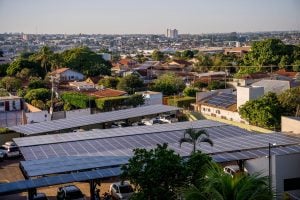The northern summer of 2024 didn’t just break records. It shattered the illusions held by climate sceptics. As thermometers in Beijing hovered near 40C and hospitals across the hemisphere overflowed with heatstroke patients, one message became unmistakable: the era of climate consequences has arrived.
This new reality is rewriting the rules of energy security and no nation is exempt. In China, the US and India, unrelenting heatwaves forced grids to the brink as electricity consumption rose to historic highs, largely to power air conditioners. The scorching months saw coal and gas plants roaring back to life. Those countries are prime examples. They are home to the world’s three largest electricity markets, together accounting for over half of global demand. It was a stark reminder that fossil fuels remain the fallback when extreme weather strikes.
From Texas to Tamil Nadu, power grids have been buckling under unprecedented demand for cooling, exposing a paradox of the energy transition. Even as renewable capacity expands, old fossil infrastructure continues to serve as a crutch during extreme stress.
China, home to the world’s biggest clean-power system, epitomises this challenge. Despite its inexorable march toward renewable energy, the country’s rapidly expanding clean-power system remains insufficiently resilient to withstand extreme conditions. In 2024, when temperatures spiked, the old coal-centric system had to step in to bridge the gap, as we explain below.
By 2050, global cooling demand could more than double, posing an even greater challenge for China and the world’s energy transition. For China, the task ahead is not only to scale up renewable-energy supply, but to fundamentally re-engineer the entire power system, making it more flexible, intelligent and climate-proof.
Cooling homes is straining grids
Last year, heatwaves and a longer, hotter summer were key drivers of China’s year-on-year electricity demand growth. Our recent report at Ember quantifies the monthly impact of these temperature changes.
The findings are stark. Between April and September 2024, electricity demand increased by 7% compared to the same period in 2023. An estimated 31% of the increase stemmed from higher cooling needs. This amounts to an estimated 102 terawatt-hours of additional electricity use for cooling compared to the same period in 2023 – enough to power all of Algeria for a year.
The temperature effect was especially strong in August and September, with average population-weighted temperatures reaching 26.5C in August and 23.1C in September – the highest in a decade.
This is a measurement of temperature that takes into account population density.
Traditional temperature measurements provide the average temperature of an area – a very large one in the case of a country like China. But the human impacts of temperature depend on population density. For example, a 40C heatwave in the Gobi Desert would have a much smaller impact than one in Beijing.
So we divided China into 30km by 30km squares and weighted each square according to its population size. This metric allowed us a view of temperature that is more relevant to how heatwaves influence electricity demand.
Cooling demand doubled the year-on-year electricity demand growth. Without it, electricity demand in August would have grown by just 4%, instead of 9%. And in September it would have increased by 4.4%, rather than 9%. China was not the only country to experience this: in the US, electricity demand would have fallen by 1.3% in June, but cooling needs resulted in a 9.4% rise instead.
This pattern is no outlier. In 2022, a historic 70-day heatwave coincided with China’s worst drought in 60 years. In Sichuan, a hydropower-dependent province, reservoirs dried up, slashing electricity output by 50%. Cooling demand spiked substantially. Even coal plants running at maximum operation couldn’t prevent factory shutdowns. Again in 2023, Henan and Shandong provinces endured temperatures above 40C on multiple occasions, pushing July’s electricity demand to a record high and forcing grid operators to resort to rolling blackouts.
The implications are dire: climate-driven heatwaves force reliance on air conditioning, which strains grids, perpetuating the need for fossil fuels. Worse, this is only the beginning. Climate models show that at 2C of warming, such extremes will double in intensity; and at 3C, they will quadruple.
Growing pains for the new system
China’s power system is in the midst of a major transition, guided by the principle of “building before breaking”. This cautious approach prioritises scaling up clean-energy supply before phasing out fossil fuels. The logic is clear: a country is more likely to retreat from coal when it is confident that clean electricity can reliably meet demand at scale and with affordable costs.
The progress has been staggering. Wind and solar capacity increased by 34% in the past year alone. As of June 2024, combined wind and solar capacity has exceeded that of coal, and is on track to exceed total thermal-generation capacity this year.
As China’s renewable-energy system expanded at an impressive rate, coal has been in relative decline. While coal once dominated, accounting for over 70% of electricity generation in the mid-2000s, it has been growing more slowly than electricity demand and losing market share to the new power system. Its share fell to 54.8% last year.
However, the heatwaves of 2024 revealed how far China still has to go. The new clean-power system, while growing quickly, is not yet mature enough to ensure uninterrupted supply, especially as climate change drives more frequent and intense extreme weather. When demand peaked, the old system ‒ anchored by coal ‒ had to step in to bridge the gap.
In August, coal generation was 4.4% higher year-on-year, more than double the 2024 annual average increase. In September, coal generation jumped even more sharply, increasing by 10%. Across August and September, coal generation increased by a combined 68 terawatt-hours, accounting for 59% of the annual increase in China’s coal generation in 2024.
Scaling up and becoming more flexible
To break the fossil-fuelled feedback loop, scaling up clean electricity capacity and continuing to improve air-conditioning efficiency are crucial. They are, however, only part of the solution. A grid increasingly dominated by weather-dependent renewables must also incorporate greater flexibility in order to withstand climate extremes.
One solution is to accelerate the deployment of energy storage, such as grid-scale batteries and pumped hydro, to capture midday solar surpluses and deploy them during evening air-conditioning peaks. Innovative long-duration energy-storage solutions ‒ such as thermal storage (using molten salt or rock) and green hydrogen ‒ are also critical to addressing week- or even month-long seasonal variations in renewable-energy generation.
Rewiring electricity markets to dismantle provincial silos ‒ by introducing dynamic pricing and cross-regional trading mechanisms ‒ could further incentivise better sharing of surplus renewables across the country, ensuring clean power reaches places where it’s needed most.
Moreover, climate-proofing the power grids is now urgent. Heatwaves, droughts, and storms must be treated as routine, not exceptions. Cities need heat-resistant transmission lines, flood-proof substations, and decentralised solar-storage microgrids to sustain critical services during extreme conditions.
Collectively, these steps would transform China’s power system from one that merely survives climate shocks to one that thrives despite them.
China’s struggle is a global warning. The path forward demands more than clean megawatts. It requires reinventing grids to be resilient, responsive and relentlessly adaptive. By doing so, China can secure a future where clean, reliable electricity powers its people’s pursuit of a better life, and serve as the blueprint for a world facing the same existential test.








